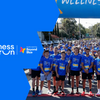How to Bounce Back After a Marathon - Top Recovery Tips
So, you’ve just crossed the finish line of a marathon or ultramarathon—first off, huge congratulations! Whether you smashed a PB or just managed to keep your legs moving to the end, you’ve done something most people only dream of.
No, seriously. What an incredible effort. You've put in the training, you've endured real pain and you made it to the finish line.
But now what? How do you stop feeling like you’ve been hit by a truck and get back to feeling human again? Let’s talk recovery, because how you treat your body after a big race is just as important as how you trained for it.
After you finish the race you may well feel like you never want to run again. Like, ever. You're done. But within a few days, you'll be Googling your next big race.
It's the natural rinse and repeat for runners!
Recovery is your body’s way of saying, “Hey mate, that was intense—let’s fix what we just broke!” We’re going to cover all the essential steps to help you bounce back without turning into a hobbling mess. Well, too much of a hobbling mess anyway.
Immediate Post-Race Recovery: The First 24 Hours
Rehydrate and Refuel

I remember after my first marathon. After I finished there was this huge ramp that all runners were being funneled down after the finish line. My quads were burning.
Myself and several other runners were holding onto the railing for dear life. It was completely painful and at that moment I wondered if I'd ever walk again, let alone run.
After hours of sweating it out, you’re probably dehydrated and running on empty. Water is your best friend right now, but don’t stop there—electrolytes are key. Sports drinks, coconut water, or those electrolyte tablets you see all the pros using will do wonders. It's important to just rehydrate your body after a gruelling run.
And if you had the foresight to wear a RUNLY R700 Hydration Vest, you’re already ahead of the game, keeping hydrated like a champ during the race. But now, grab a drink and get those fluids back in.
Next up—food.
No, not that burger and chips you’re craving just yet. Start with something that’ll actually help your muscles recover, like a banana and some peanut butter. The heavy stuff can wait till later - you deserved it.
Keep it really simple for your first snack. You need to refuel, but the chances are your body is not going to be screaming out for a big meal despite burning almost 3,000 calories in a matter of hours.
Light Movement and Stretching

Now, you might be thinking, “I’ve just run a marathon, why would I want to move?” Fair point! But trust me, light movement is your secret weapon. Go for a little walk (yes, even if you feel like Bambi learning to walk), and it’ll help flush out that lactic acid. After that, give your muscles some love with a few gentle stretches—your calves and quads will thank you tomorrow.
Again, keep it really simple. Don't force anything that doesn't feel right. Take it slow.
Rest and Sleep

Ah, sleep. The ultimate recovery tool. Get a solid night’s sleep and let your body do its thing. That’s when muscle repair kicks into overdrive, and you’ll wake up feeling (a little) less like a zombie.
Day 1 to Day 3: Active Recovery and Muscle Care
Gentle Activities

Your legs might still feel like jelly, but the key here is active recovery—a fancy way of saying, “keep moving, but don’t overdo it.” Go for a walk, take a light bike ride, or if you’re feeling brave, hit the pool or beach. Nothing too intense, just enough to keep your blood circulating and muscles loosening up.
Massage and Stretching Routines

If you’ve got access to a foam roller or one of those fancy massage guns, now’s the time to use them. Spend 10-15 minutes each day on your tightest spots—probably your quads, hamstrings, and calves—and keep things loose.
Don't go too hard here, your muscles are still repairing and you just want to keep the blood circulating without pushing it too hard.
Nutrition for Recovery: Refuel with the Right Foods

Carbohydrates and Protein
Your body has just burned through its glycogen stores (aka all your energy), so now it’s time to refuel. Carbs are going to help you restore those energy levels, while protein is essential for muscle repair. Think grilled chicken with sweet potato or a veggie-packed pasta dish.
Feel like a Maccas run? That can work too. But don't go overboard on the fast & oily food.
Supplements and Hydration
Top up on electrolytes and stay hydrated. You don’t need to chug water constantly, but keep a bottle nearby and sip throughout the day. And, of course, the a hydration vest is always a solid companion for those post-race walks or light runs when you’re ready to get moving again.
Sleep and Mental Recovery

Sleep's Role in Muscle Repair
Sleep is like the unsung hero of recovery. When you hit deep sleep, your body starts repairing all those micro-tears in your muscles. So don’t feel bad about catching a few extra hours of shut-eye in the days after your race.
Some people are good 'sleepers' and others just aren't. I am certainly the latter. I struggle to just completely let go, or sleep in too long. If that's you, you've gotta tell yourself to just lay there. Put your phone in another room and get some shuteye.
If it doesn't work for you, don't hesitate about taking a quick afternoon nap to catch up on an hour of sleep.
Mindset Reset
And let’s not forget about your mental recovery. It’s completely normal to feel a bit lost after a big race—some call it the post-race blues. Take some time to reflect on what you’ve just accomplished, maybe write about it in a journal or chat with your running mates. You've earned this rest!
Keep your mind relaxed, yet busy. There's a bunch of great meditation apps like HeadSpace to level out.
Long-Term Recovery: When to Start Running Again

Listening to Your Body
For my entire athletic journey, people always said 'listen to your body'. And I was always like 'yeah cool, but what on earth does that mean'. It wasn't until later on, perhaps in my late 20's where I actually started to understand what my body is saying, what it can do, and what it shouldn't do.
I think that comes with athletic maturity.
The big question: when can you start running again? There’s no rush, honestly. Your body needs time to heal, so listen to it. Some people can start jogging again within a few days, but others might need a couple of weeks. Just take it slow, and don’t push yourself too soon.
Preventing Overtraining
It’s tempting to jump straight back into training, but overtraining is a real risk. Give your body the break it deserves, and when you’re ready, ease back into your running routine. Maybe start with shorter runs and build your way back up.
One of my favourite long-distance runners, Sally McRae talks about running in 'seasons'. You define your own running season, and you define your 'off-season'. It's important to take some down time from training and do something different.
As much as it is a physical break, it's also a mental break. Things like focusing on yoga, strength training, bike riding, hiking or ball-sports can offer a much needed mental break from running while still providing physical benefits.
Recovery might not be the most glamorous part of running, but it’s absolutely essential if you want to keep turning up to races in good condition, year after year. So, take the time to rest, refuel, and reset—you’ll be back at it in no time, feeling stronger than ever.





